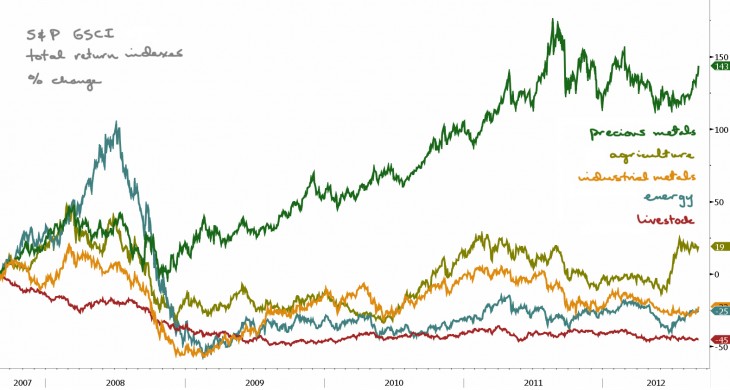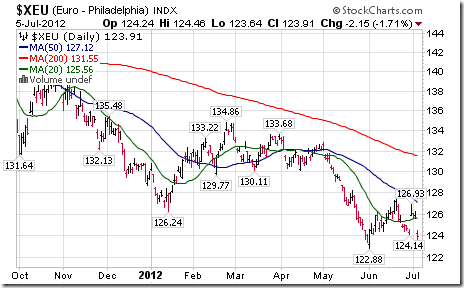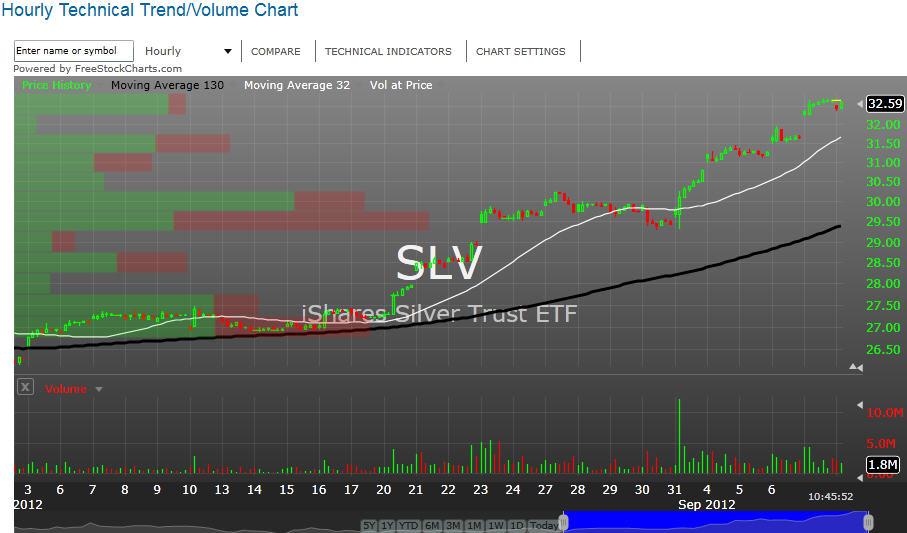Bonds & Interest Rates
Global authorities are ramping up the stimulus… the Authorities hit the accelerator, the ECB plans to buy bonds, the Chinese announced big infrastructure spending programs, the Fed looks set for QE3 come Sept 13, and the BOJ will likely add to the joy come Sept 19.
Market reaction: Gold rallied over $150 since mid-August to its best level in 6 months, the S+P 500 had its best weekly close since 2007, the recently suspect EURUSD rallied to a 4 month high and the CAD closed over 1.02 for the first time in a year.
Trading: US Stock Indices: I’ve been on the sidelines since selling out Sept 21. Gold: I missed the rally, I’m tempted to sell short here but that would break my trading rules, CAD: I’m watching for a set up to sell OTM calls to rebalance my long term savings currency hedge, Crude: I’m lightly short (the rally off the June lows stalled at .618 of the Mar/Jun decline, Ross Clark has a Sequential Sell Setup, COT analysis.) My trading instincts tell me that this rush higher in risk assets has been a “sugar rush” and I am strongly tempted to sell it short across the board…I haven’t because that would be top picking…and picking tops and bottoms has a low probability of success! (Very tempted, though!)
Big Picture Thoughts: These days the Authorities would rather see inflation than deflation and they will act accordingly…but do they have the power to counter the forces of deflation in today’s world…is inflation or deflation in our future? For me this is not an academic question…getting this right could be the biggest and best trade I ever made!
The Authorities didn’t always prefer inflation. Volker took bold steps 30 years ago to “break the back” of inflation and inflationary expectations…he obviously had the power to succeed.
At the root of my skepticism about the Authorities having the power to counter the forces of deflation is the notion that the deflationary forces they hope to overcome have been precipitated by something far larger than a typical post WW2 recession…that these deflationary forces have been created by the confluence of a number of contributing factors…starting with the credit bubble collapse after the biggest credit boom in human history…but certainly also including deflationary demographic trends…the deflationary impact of globalization…the Internet…and good old over-supply in the face of falling demand!
I’m not an economist, and I’m not trying to win hearts and minds here, I’m just a trader posing a question…but as noted above, I think getting the answer to this question right could lead to the biggest and best “trade” of my life. Bill Gross HERE and Frank Giustra HERE have both recently made a strong case that expecting inflation is the way to bet. They are both very thoughtful men with impressive track records. Who am I to disagree?
Well, we could all be right…it’s a matter of timing and definition. As a trader I’m always trying to sync my trading with the time frame of my analysis…to do otherwise usually causes confusion and losses. But how do I define inflation and deflation? Yes, I’m aware of the classic monetarist view of, “Too much money chasing too few goods,” but for the purposes of “finding the trade” I’m going to take the view that inflation means rising prices…and that is not monolithic…therefore the Authorities could cause inflation (or price increases) in some things while the prices of other things are pulled lower by deflation…and some things will be “on the bubble”…maintaining a shaky price equilibrium while being buffeted by both inflationary and deflationary forces. (The Authorities may also be more interested in rekindling inflationary expectations than actual inflation…but that will be an uphill battle given the weakness in the labor and housing markets.)
Financial assets and commodities (not including iron ore and coal) have been bid higher as the market perceives another period of stimulus. Will these markets continue higher or is this “Financial Heroin,” to use Donald Coxe’s term, going to wear off quickly leaving financial assets and commodities to fall? Do the Authorities have the power to make inflation happen…or not?
It seems that consumer spending is the biggest force in the economy…and I wonder if consumers aren’t getting tapped out…financially and demographically. I wonder if they have used too much credit to buy “stuff” and are now at risk of setting off a vicious circle of deflationary trends if either the economy slows or interest rates rise…or both of those things happen. I wonder if manufactures made a boo-boo and figured that consumers would keep buying “stuff” and now those same manufacturers are sitting on warehouses full of inventory…financed by banks…and if that inventory doesn’t move the manufactures will have to lay off workers…making their contribution to the vicious circle of deflationary trends.
Inventory is not just in warehouses…for instance, I see a “shadow inventory” of nearly new Harley Davidson motorcycles sitting in consumer’s garages all over North America…if the economy goes soft these used Harleys will be on offer…deeply discounted to the new ones in the showrooms. My mechanic friend tells me that the bottom has fallen out of the used car market as new car lease terms have been extended past 8 years…lower prices on used cars may become a “shadow inventory” that haunts car makers…an over-supply of “stuff,” in other words, may strengthen deflationary trends.
My deflation bet: I rent a lovely condo on Vancouver’s waterfront…I have no interest whatsoever in buying real estate here. My long term savings are mostly in cash (I note that BOC Governor Carney has been hectoring Corporate Canada to start spending some of the record large mountain of cash they are sitting on…I therefore take some comfort in sitting on my own record large pile of cash!)
Article provided by:
Drew Zimmerman
Investment Advisor
Union Securities Ltd. | Vancouver, BC
Tel: 604-646-2031 | Fax: 604-646-2067
Email: dzimmerman@union-securities.com
Web: www.union-securities.com
Victor Adair
Victor Adair is a Senior Vice President and Derivatives Portfolio Manager at Union Securities Ltd. Victor began trading financial markets over 40 years ago and has held a number of senior positions during his long career as a commodity and stockbroker. He provides daily market commentary on CKNW AM 980 radio Vancouver and is nationally syndicated on Mike Campbell’s weekly Moneytalks radio show. Victor’s trading focus is primarily on the currency, precious metal, interest rate and stock index markets and his clients are high net worth individuals and corporations.
You can reach Victor Adair at:

Jared Cummans: Marc Faber, who shares the moniker “Dr. Doom” with Nouriel Roubini, has made a name for himself not only from his intelligence, but also from his outspoken and often controversial views. Faber has recently predicted a 100% chance of a U.S. economic recession and says that he is simply waiting for things to fail. To put things lightly, he is something of a bear, as he often points out the faults of the economy or singles out failing sectors. It seems as though he has done it again, but this time with industrial commodities, namely industrial metals [for more industrial metals news and analysis subscribe to our free newsletter].
Commodities like copper, steel, aluminum, and others have struggled as of late given the shaky economic indicators from around the world. Faber notes that“industrial commodities will remain under pressure due to the fact that the Chinese economy is slowing down considerably”. While it is important to realize that the Chinese are intentionally subduing some of their growth; it has been a rising issue for investors around the world for some time now. China’s GDP growth has been dropping for nearly two years, worrying many that this dominant emerging market is beginning to slow down.
Of course, slowing down still holds a growth rate of more than 7.6%, a figure that looks quite robust when set next to the U.S. growth rate of just 2.3%. But the shrinking figure is still worrisome, as China is the one of the world’s largest consumers and producers of industrial metals like copper among others. If China were to cut its demand prospects from something like copper or steel, it could have devastating impacts on the commodities themselves, according to Faber’s theory. Below, we outline several options to make a play on Faber’s prediction [see also Why Bill Gross Thinks The Fed is Ruining The Economy].
- DB Base Metals Fund (NYSEARCA:DBB): This product invests in futures for aluminum, zinc, and copper, with each commodity receiving an equal weight. The fund has roughly $315 million in assets and trades nearly 90,000 times each day.\
- DJ-UBS Copper Total Return Sub-Index ETN (NYSEARCA:JJC): For those looking to single out copper exposure, this fund will be the most popular option. JJC invests solely in front-month copper futures and trades more than 55,000 every day [see also Three Commodities to Bet With Buffett].
- Rio Tinto (NYSEARCA:RIO): Rio is one of the largest mining firms in the world, giving you an indirect exposure to a firm whose revenues will be directly impacted by the prices of the commodities they extract. The company’s main outputs are iron ore, copper, coal, and aluminum among others.
Via David Bettencourt of ETF Daily News
Written By Jared Cummans From CommodityHQ Disclosure: No Positions.
CommodityHQ offers educational content, analysis, and commentary on global commodity markets. Whether you’re looking to speculate on a short-term jump in crude or establish a long-term allocation to natural resources, CommodityHQ has the information you need.

The Bottom Line
Downside risk exceeds upside potential in equity markets during the next six weeks. The breakout by the S&P 500 Index last week implies that depth of the downside risk is less than previous. Selected seasonal trades continue on the upside (gold, energy, software) and downside (transportation). However, many of these seasonal trades reach the end of their period of seasonal strength this month. September is a month of transition. Trade accordingly.
Equity Trends
The S&P 500 Index gained 26.79 points (1.90%) last week. Intermediate trend is up. The Index broke above resistance at 1,426.68 to reach a four year high. The Index remains above its 50 and 200 day moving averages and moved above its 20 day moving average. Short term momentum indicators have rebounded to overbought levels.

The TSX Composite Index added 185.78 points (1.54%) last week. Intermediate trend is up. The Index broke above resistance at 12,196.77 on Friday. The Index remains above its 50 day moving average and moved above its 20 and 200 day moving averages last week. Short term momentum indicators have recovered to overbought levels. Strength relative to the S&P 500 Index has changed from negative to at least neutral.

Seasonality refers to particular time frames when stocks/sectors/indices are subjected to and influenced by recurring tendencies that produce patterns that are apparent in the investment valuation. Tendencies can range from weather events (temperature in winter vs. summer, probability of inclement conditions, etc.) to calendar events (quarterly reporting expectations, announcements, etc.). The key is that the tendency is recurring and provides a sustainable probability of performing in a manner consistent to previous results.
Identified below are the periods of seasonal strength for each market segment, as identified by Brooke Thackray. Each bar will indicate a buy and sell date based upon the optimal holding period for each market sector/index.

….go HERE to view Equity Clock’s Seasonality Chart for 26 other individual sectors, Commodities, Bonds etc.
Other Issues
Two unexpected events last week triggered a surprising upside move in equity markets last week, China’s $150 billion fiscal stimulus package announced on Thursday night and the ADP report showing a gain in U.S. private employment in August instead of a loss. Gains were muted on Friday when the less than expected U.S. employment report was released.
The economic focus this week is on the FOMC meeting. The Fed widely is expected to announce an additional monetary stimulus program that probably will include the purchase of mortgage backed securities by the Fed that effectively will replace Operation Twist that is expected to expire at the end of the month. However, the effectiveness of a new program is somewhat suspect. At best, it may reduce mortgage rates slightly, but mortgage rates already are near all-time lows. Importance of an additional monetary stimulus program is psychological (Investors relate monetary stimulus to higher equity prices). If the Fed chooses not to introduce another stimulus program, equity markets are vulnerable to significant short term downside risk. If the Fed chooses to go beyond a token purchase (or promise to purchase) mortgage backed securities, equity markets will move higher. The Fed in order to show political neutrality is unlikely to act beyond the September FOMC meeting until after the election.
U.S. economic news other than the FOMC meeting is expected to be neutral to slightly bearish for equity markets this week (higher trade deficit, higher inflation, higher inventories, lower consumer sentiment, but continuing strength in retail sales).
Macro events outside of the U.S. once again focuses on China this weekend and Europe later this week. Negotiations between ECB President Draghi and Greece continue on Tuesday. The German constitutional court rules on the eligibility of ECB lending on Wednesday. The Netherlands holds parliamentary elections on Wednesday.
Short and intermediate technical indicators for most equity markets and sectors improved last week but have returned to overbought levels.
North American equity markets have a history of moving lower from September to mid-October during a U.S. Presidential election year(particularly when polls show a tight race as indicated this year). Thereafter, equity markets move higher.
Cash on the sidelines on both sides of the border is substantial and growing. However, political uncertainties (including the Fiscal Cliff) preclude major commitments by investors and corporations before the Presidential election.
….read more & view 50 charts on Commodities, Interest Rates, Currencies HERE
I fail to see the merit in Mario Draghi’s approach to the euro crisis. Buying “unlimited amounts” of bonds from indebted sovereign euro countries and then “sterilizing” the printed money is simply not going to work.
First, Germany’s Bundesbank, by far the most powerful national central bank in the euro zone, is not squarely behind the deal. That’s not a good sign.
Just hours after Draghi announced the plan, Germany’s Finance Minister Wolfgang Schaeuble also jumped into the fray, warning that he stood against the European Central Bank’s (ECB) bond-buying plan.
Second, Draghi plans on sterilizing the money printed by his bond-buying. That means the ECB will issue its own debt to mop up the money it’s printed. So there will be no net increase in the monetary base, which is dis-inflationary … at a time when precisely the opposite is needed, a dose of inflation.
Third, the sterilization will cause even more problems. The only countries that can afford to buy ECB bonds to mop up excess money printing are the rich euro-zone countries, mainly Germany and France.
Think that through. It means the bonds the ECB does buy, from failing sovereign nations, will put money in their coffers … while the bonds the ECB issues will take money out of the coffers of the richer nations.
Do you think Germany and France will like to see their liquidity tightened while their suffering neighbors get all the benefits? I don’t think so!
Fourth, by driving down short-term yields on sovereign bonds in heavily-indebted and busted euro-zone countries, the ECB will effectively shorten those countries’ debt maturities.
With those busted countries falling deeper and deeper into a depression, that will merely serve to make their debt loads worse in the longer run, because debt will have to be rolled over more frequently.
Fifth, the indebted nations of Europe that will get the aid will have to get their fiscal houses in order by complying with strict policies put out by the ECB. If they don’t, then the ECB backs away from buying and supporting their bonds.
Guess what? The ECB-imposed austerity measures will merely serve to make the debt crisis worse. And that’s assuming countries like Spain, Italy, Portugal, etc. will be able to comply with strict austerity measures in the first place.
That’s highly unlikely. Just look at how Greece has gone down the tubes with austerity measures that, in turn, forced it to go hat-in-hand time after time for more bailouts.
Put another way, if Spain, Italy, Greece etc. can’t comply, they lose the ECB backing. And if they do comply, their economies simply crater more.
In short, there is no way Draghi’s plan is going to work. The markets, most of which have rallied sharply on the news, are headed for one of the biggest disappointments I’ve ever seen. The gap between hope and reality has never been wider.
I see more trouble ahead, too. This Wednesday, Germany’s Federal Constitutional Court will decide the legitimacy of the European Stability Mechanism, the funding vehicle for bailout money. There’s a chance it will decide against it, which would put Draghi’s plan in jeopardy.
In addition, our Fed meets this Thursday and the majority of investors and traders are expecting Ben Bernanke to announce another round of money-printing.
They’re going to be sadly disappointed. Bernanke will do no such thing. While he will give the usual rhetoric that the Fed stands ready to print, and perhaps may give a few more clues about it, I strongly believe that the Fed will not initiate any money-printing until after the elections, at the earliest, and more likely, not until early 2013.
Bottom line: I don’t like what I’m seeing in the markets. It’s not just my gut, not just my interpretation of the news or fundamentals either.
- While the S&P has marched to a new recovery high, it remains largely unconfirmed by the advance/decline ratio, by volume, and by the Dow Transports.
- While gold has rallied to just above $1,700, it has thus far failed to take out my system resistance at the $1,727 level, let alone monthly resistance at $1,740 to $1,750.
- While silver has exploded higher too, it has also failed to take out monthly resistance at the $34 level.
Meanwhile, the euro remains below monthly resistance at the 1.28 level and the dollar is holding monthly support at the 80 level in the nearby Dollar Index futures. Crude oil has failed to get above important resistance at the $100 mark.
I see a giant trap about to slam shut. A lot of investors are going to get hurt. Don’t be one of them.
Until next time …
Best wishes,
Larry
P.S. From ECB meetings to the upcoming Fed meeting to the never-ending saga of European sovereign-debt problems, September is filled with uncertainty. But it’s also filled to the brim with opportunity. And in my Real Wealth Report, I help you seize the profit potential from the opportunities these events create. Activate your risk-free trial subscription by simply clicking here now!

















